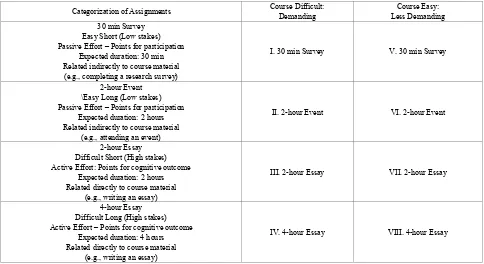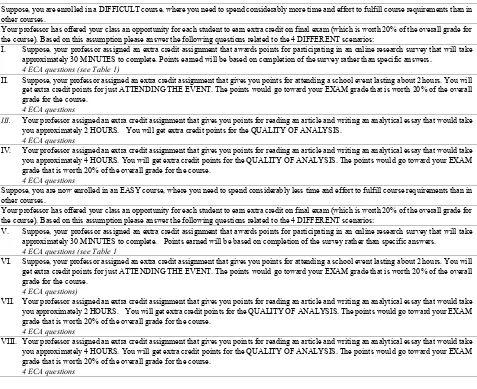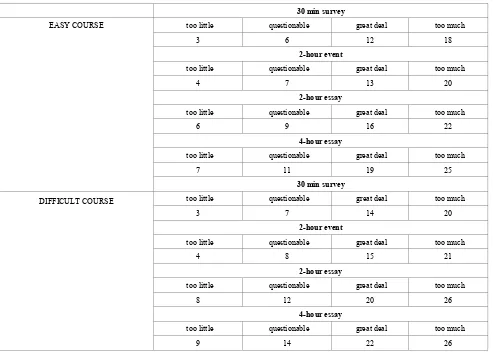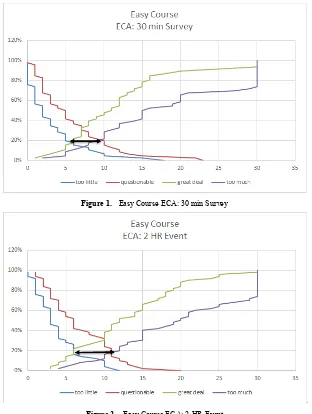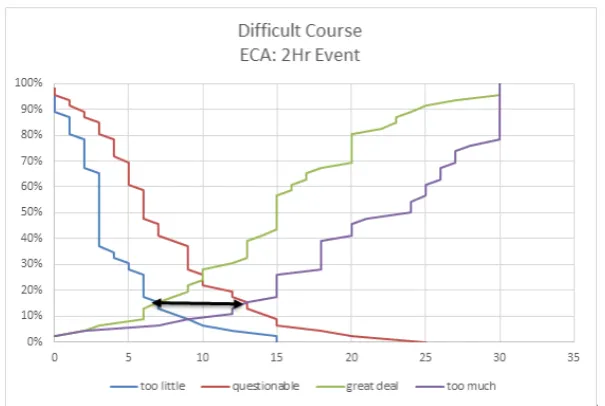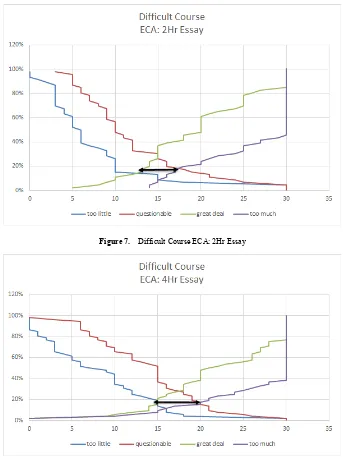Sensitivity Analysis of Extra Credit Assignments
Julita Haber
1,*, Nina Sarkar
21Gabelli Schools of Business, Fordham University, United States
2Department of Business, Queensborough Community College, City University of New York, United States
Copyright©2017 by authors, all rights reserved. Authors agree that this article remains permanently open access under the terms of the Creative Commons Attribution License 4.0 International License
Abstract
In post-secondary management education, students receive course grades that often include points for extra credit assignments (ECAs). Although ECAs abound on college campuses we found that the literature lacks specific guidelines for faculty on how to use ECAs effectively to facilitate students’ learning. To address this gap, the study examines the relationship between students’ effort needed to complete an assignment and the number of extra credit and points student expect to get in return. Based on data collected from a sample of 102 college students, we calculated acceptable point ranges for faculty to use for four commonly found ECA types in management education. We employed a technique used in research pricing referred to as Van Westendorp’s price sensitivity analysis and modified it to the extra credit setting. Further, our results indicate that there is a non-linear relationship between effort and expected credit points, and this effect is varied by difficulty of course. We conclude with key observations and suggestions for management education and future research.Keywords
Extra Credit Assignment, Management Education, Sensitivity Analysis1. Introduction
In post-secondary education, extra credit assignments (ECAs) are being used as a means to assist students to successfully complete a course [1, 2]. In addition to regular course requirements, ECAs are optional assignments that students can complete in order to earn additional points toward their course grade [3]. They may include assignments such as writing an essay, attending a college event or participating in a study.
A large number of college students prefer extra credit education model and believe that ECAs or make-up assignments should be available to improve their grades [4,5]. This trend of rising students’ desire for ECAs can be attributed in part to the current “consumerist” orientation in the marketplace and its effect on students, who now demand and expect bonuses and extras on a daily basis. Amidst
student pressure [1] it is important to determine how ECAs can be used systematically in the most effective way to impact student learning [4].
Moreover, many faculties spend significant amount of time designing, administering, and grading ECAs without sufficient and precise knowledge of how this effort justifies the learning outcome or if it does so at all [5]. Faculty today predominately relies on their intuitive knowledge and scant scientific evidence for designing and administering ECAs for their courses. There is limited rigorous evidence about ECAs [6] and limited guidelines for instructors on how to assign ECAs in a classroom [4, 7].
This paper explores the relationship between extra credit points and students’ effort on ECAs. Relying on price sensitivity analysis of Van Westendorp and adapting it to the extra credit context, we calculate a range of acceptable points that faculty can use. We gain a better understanding of students’ expectations of extra credit points for particular ECAs and share our findings and observations for faculty to use in management education. Lastly, we conclude with key observations and suggestions for faculty and future research to advance systematic and evidence-based inquiry of ECAs.
1.1. Literature Review
Our literature review found, that to date, research on ECAs has focused primarily around three major themes. The first theme covered two opposing faculty orientations toward ECAs across disciplines. Many studies covered debates about the appropriateness of the use of extra credit in post-secondary education [8,9] with two polarized perspectives concerning the use of extra credit among college-level faculty across disciplines [2,10]. Negative perceptions toward ECAs have been voiced in several studies [11]. It was reasoned that ECAs were, for example, encouraging lax and irresponsible behavior among students [1]; contributing to grade inflation [5]; touching on moral code and unethical pedagogy [12, 13]; motivating learners through inadequately designed courses [14]; and leading to unexpected outcomes [9]. The reason for faculty’s negative impression of ECAs may stem from poorly designed ECAs [12].
perceived as an alternative means of student evaluation and a second chance at improving academic performance [1]. Empathy for students, fondness to see students succeed, and a genuine desire to encourage better work ethic have been viewed as key characteristics of faculty supporting ECAs [15]. Although the ECA controversy has not diminished in academic circles, there has been a strong and salient evidence of the wide usage of ECAs in college classrooms since the 1980’s [1,2].
The second theme included measurable and anecdotal learning outcomes attributed to ECAs. Studies across disciplines documented ECA outcomes ranging from increased student engagement and attendance [16]; enhanced motivation, attendance, and exam preparation [17]; exposure to academic research [6]; enhanced problem solving and covering more curriculum [12]; increased subject matter knowledge, higher motivation, and improved perception of the instructor [7]; quality writing [12]; positive attitude and excitement for learning [19]; extending knowledge beyond the classroom [20]; and improved course exams and grades [4,21]. Significant positive correlations were found among rated ECAs educational value, usage, and access–the likelihood that all students would be able to complete the assignment [2]. Most studies involving ECAs, however, were based in psychology [3,18,22,23].
The third theme included students’ preference and motivation for engaging in ECAs. In contrast to some faculty concern, students widely endorsed the use of ECAs [1,5,8,24]. Students often believe an ECA will transform them from a nonexistent to a substantive entity in the mind of the instructor. This belief coexists with their other view of ECA as a safety net to ensure a satisfactory grade in a course [8]. In one study with 37.8% of students completing the ECAs, it was found that those enrolled in courses with higher enrollment were more likely to take advantage of the optional assignments [24]. The better students were more likely to complete ECAs [21,24,25,26]. The same applied to female students and those taking a course in their majors [4,24]. Reasons for completing ECAs ranged from academic (e.g., not interested in the topic) to personal (e.g., illness) [27]. In some cases, students were more motivated to perform the ECA than the original required assignment [10]. The above research failed to examine the impact of the number of credit points on student motivation and voluntary participation in ECAs.
In summary, besides psychology, hospitality, and general science, many academic fields such as business management, have not been widely represented in the ECA studies. We found no overarching research or pedagogical framework that would support using ECAs as a valid pedagogical tool in college education. Specifically, our review failed to find an ECA typology and no guidelines for faculty on the optimal number of points to assign to an ECA in secondary-level education.
1.2. Purpose
This study aims to identify the most optimum number of
points to be assigned for an ECA to benefit student learning outcome so that faculty does not give out too many points unnecessarily causing grade inflation and that the point number is sufficiently enough to motivate students to participate in the ECA. Our main research question is as follows:
RQ: How many extra credit points should faculty assign to a particular assignment? In other words, what is the fair value of the ECA to have the largest impact on student participation and learning?
1.3. Theoretical Background
We ground our inquiry in equity theory [28]. Driven by its basic premise we theorize that assessing the worth of ECAs is influenced by the ratio of expected inputs and outputs. In decisions to purchase goods or engage in voluntary activities, people assess value and seek a fair balance between what they put into a task (inputs) and what they get out of it (outputs). Inputs can include effort, loyalty, hard work, commitment, or skill. Outputs can be both quantifiable rewards, such as pay, bonus, or grades and intangible rewards such as recognition and praise. The perceptions of what constitute a fair balance or trade of inputs and outputs is influenced by situational context and one’s social network.
We contextualize the concept of inputs and outputs and apply it to the extra credit setting. Students' decisions to participate in ECAs are influenced by their fair value assessment of the assignment. Their input is operationalized as the amount of time and cognitive effort students take to complete an assignment, whereas the output is the amount of extra credit points the students will be awarded for completing the assignment.
2. Method
Our methodology involved collecting data through a cross sectional online survey in Qualtrics aimed at college-level student body and conducting a point sensitivity analysis to uncover a quantifiable relationship between extra credit points and estimated student effort for four ECA types.
2.1. Van Westendorp Method
distribution of perceptions and calculates an acceptable price range for the product. It has been found to be superior over other direct methods [30] because it captures an inherent product value denoted by price.
The Van Westendorp method is well suited for the ECA setting because students are highly experienced about ECAs and can be explicitly asked about them. First, we mapped each of the four Van Westendorp’s sensitivity analysis questions to the extra credit point context (see Table 1). Here, a Van Westendorp product is treated as an ECA.
2.2. Survey Design
[image:3.595.59.547.226.368.2]Based on the literature review and our own pedagogical experience with ECAs, we identified four different types of ECAs to include in the survey. We chose assignments that vary on four dimensions: low or high stakes, students’ passive or active cognitive effort, duration, and direct or indirect relation to the core curriculum.
Table 1. Adaptation of Van Westendorp Questions to the ECA Context
Series of Van Westendorp Questions Four ECA Questions 1. At what price would you begin to think product is too
expensive to consider?
1. At what point would you begin to think the number of credit points awarded for the assignment would be…too little for the amount of effort (i.e., time invested and
engagement in task)? 2. At what price would you begin to think product is
getting expensive, but you still might consider it?
2. At what point would you begin to think the number of extra credit points awarded for the assignment would be…questionable for the amount of effort (i.e., time invested and
engagement in task), but you still might consider it? 3. At what price would you think product is a bargain –
a great buy for the money?
3. At what point would you begin to think the number of extra credit points awarded for the assignment would be…a great deal for the amount of effort (i.e., time invested and
engagement in task)? 4. At what price would you begin to think product is so
inexpensive that you would question the quality and not consider it?
4. At what point would you begin to think the number of extra credit points awarded for the assignment would be…too much for the amount of effort (i.e., time invested and
[image:3.595.63.547.392.656.2]engagement in task) that you would question the quality of the assignment?
Table 2. Selection of 8 ECAs Scenarios for Students to Determine Expected Credit Points
Categorization of Assignments Course Difficult: Demanding Less Demanding Course Easy: 30 min Survey
Easy Short (Low stakes) Passive Effort – Points for participation
Expected duration: 30 min Related indirectly to course material (e.g., completing a research survey)
I. 30 min Survey V. 30 min Survey
2-hour Event \Easy Long (Low stakes) Passive Effort – Points for participation
Expected duration: 2 hours Related indirectly to course material
(e.g., attending an event)
II. 2-hour Event VI. 2-hour Event
2-hour Essay Difficult Short (High stakes) Active Effort: Points for cognitive outcome
Expected duration: 2 hours Related directly to course material
(e.g., writing an essay)
III. 2-hour Essay VII. 2-hour Essay
4-hour Essay Difficult Long (High stakes) Active Effort – Points for cognitive outcome
Expected duration: 4 hours Related directly to course material
(e.g., writing an essay)
We added a contextual variable and divided the survey into two sections: difficult course that students perceive as relatively demanding and easy course that students perceive as less demanding. Students will most likely assume that they will exert more effort in a difficult course than in an easy one and they will also expect to get more points according to equity theory (Adams, 1963). In total, we formed eight different ECA scenarios for examination (see Table 2).
A typical term paper or exam in today’s academic environment can comprise 20% of a final grade. Therefore, to make the survey reflect a current academic setting, we asked students about the number of extra credits for a given assignment that would go towards 20% of their final grade in the course. For the more clarification about the survey layout, refer to Table 3. Having designed the survey, we next enrolled participants.
2.3. Participants
Our study participants were a sample of 102 college students studying business in Northeast U.S. Students were enrolled in either management, marketing, and finance course and received an extra credit for participating in the survey with a 95% response rate. The average age of the participants was 21.4 years; 59% were identified as White, 20% as Asian, 14% as Hispanics, and 8% as other races. 23% of the participants were Accounting majors, 22% Business Administration, 20% Marketing, 20% Finance, and 15% were other majors. 68% of the students reported to have a GPA from 3.0 to 3.8; 19% in the range of 2.5-3.0; 6% in the range from 3.9-4.0, and 6% below 2.5. Females represented 59% of the respondents. Sophomores accounted for 56%, juniors 24%, seniors 17%, and those pursuing graduate studies accounted for 4%.
Table 3. Survey Questionnaire Layout
Suppose, you are enrolled in a DIFFICULT course, where you need to spend considerably more time and effort to fulfill course requirements than in other courses.
Your professor has offered your class an opportunity for each student to earn extra credit on final exam (which is worth 20% of the overall grade for the course). Based on this assumption please answer the following questions related to the 4 DIFFERENT scenarios:
I. Suppose, your professor assigned an extra credit assignment that awards points for participating in an online research survey that will take approximately 30 MINUTES to complete. Points earned will be based on completion of the survey rather than specific answers.
4 ECA questions (see Table 1)
II. Suppose, your professor assigned an extra credit assignment that gives you points for attending a school event lasting about 2 hours. You will get extra credit points for just ATTENDING THE EVENT. The points would go toward your EXAM grade that is worth 20% of the overall grade for the course.
4 ECA questions
III. Your professor assigned an extra credit assignment that gives you points for reading an article and writing an analytical essay that would take you approximately 2 HOURS. You will get extra credit points for the QUALITY OF ANALYSIS.
4 ECA questions
IV. Your professor assigned an extra credit assignment that gives you points for reading an article and writing an analytical essay that would take you approximately 4 HOURS. You will get extra credit points for the QUALITY OF ANALYSIS. The points would go toward your EXAM grade that is worth 20% of the overall grade for the course.
4 ECA questions
Suppose, you are now enrolled in an EASY course, where you need to spend considerably less time and effort to fulfill course requirements than in other courses.
Your professor has offered your class an opportunity for each student to earn extra credit on final exam (which is worth 20% of the overall grade for the course). Based on this assumption please answer the following questions related to the 4 DIFFERENT scenarios:
V. Suppose, your professor assigned an extra credit assignment that awards points for participating in an online research survey that will take approximately 30 MINUTES to complete. Points earned will be based on completion of the survey rather than specific answers.
4 ECA questions (see Table 1
VI. Suppose, your professor assigned an extra credit assignment that gives you points for attending a school event lasting about 2 hours. You will get extra credit points for just ATTENDING THE EVENT. The points would go toward your EXAM grade that is worth 20% of the overall grade for the course.
4 ECA questions)
VII. Your professor assigned an extra credit assignment that gives you points for reading an article and writing an analytical essay that would take you approximately 2 HOURS. You will get extra credit points for the QUALITY OF ANALYSIS. The points would go toward your EXAM grade that is worth 20% of the overall grade for the course.
4 ECA questions
VIII. Your professor assigned an extra credit assignment that gives you points for reading an article and writing an analytical essay that would take you approximately 4 HOURS. You will get extra credit points for the QUALITY OF ANALYSIS. The points would go toward your EXAM grade that is worth 20% of the overall grade for the course.
[image:4.595.68.545.308.697.2]3. Results
Data analysis procedures followed the Van Westendorp’s sensitivity method (Van Westndorp, 1974). We organized the data for the Van Westendorp-type questions in a logical order from: too little, great deal, questionable, and too much for each ECA. Only validated responses were considered in the analysis. Responses that did not meet the ascending order criteria (i.e., “too little” <= “great deal”, “great deal” <= questionable”, “questionable” <= “too much”) were excluded from the analysis. The average of each question item on the survey is presented in Table 4.
[image:5.595.61.554.244.598.2]We first constructed histograms by plotting cumulative distributions for the “questionable” and “too much” questions and by plotting the inverse cumulative distributions for “too little” and “great deal” questions. All lines are displayed in one graph (see Figures 1-8). The graphs offer a lot of information. In Figure 2, for example, 80% of students believe that 6 points are too little for attending a 2-hour event. In Figure 4, for example, 55% of students think 20 points are a great deal to get for a 4-hour essay assignment in an easy course.
Table 4. Average of Points Attributed to Van Westendorp-type Questions
30 min survey
EASY COURSE too little questionable great deal too much
3 6 12 18
2-hour event
too little questionable great deal too much
4 7 13 20
2-hour essay
too little questionable great deal too much
6 9 16 22
4-hour essay
too little questionable great deal too much
7 11 19 25
30 min survey
DIFFICULT COURSE too little questionable great deal too much
3 7 14 20
2-hour event
too little questionable great deal too much
4 8 15 21
2-hour essay
too little questionable great deal too much
8 12 20 26
4-hour essay
too little questionable great deal too much
Sensitivity Analysis: Acceptable Range of Points for ECAs
[image:6.595.150.462.94.508.2]Figure 1. Easy Course ECA: 30 min Survey
[image:6.595.151.459.534.733.2]Figure 2. Easy Course ECA: 2 HR Event Sensitivity Analysis: Acceptable Range of Points for ECAs
Figure 4. Easy course ECA: 4HR Essay Sensitivity Analysis: Acceptable Range of Points for ECAs
Figure 5. Difficult Course ECA: 300min survey
[image:7.595.154.457.526.729.2]Sensitivity Analysis: Acceptable Range of Points for ECAs
Figure 7. Difficult Course ECA: 2Hr Essay
[image:8.595.63.552.590.741.2]Figure 8. Difficult Course ECA: 4Hr Essay
Table 5. Student Acceptable Ranges of Points for Eight ECAs (numbers extracted from Figures 1-8)
EASY COURSE DIFFICULT COURSE
Range of acceptable points Range of acceptable points
ECA Lower Bound Upper Bound Range Width Upper Bound Lower Bound Upper Bound Range Width Increase in Upper Bound Increase in
30 min survey 6 10 4 6 11 5
2-hour event 6 11 5 10% 7 13 6 18%
2-hour essay 10 14 4 21% 13 17 4 31%
4-hour essay 13 17 4 21% 15 20 5 18%
% Increase from Easy to Difficult
The Van Westendorp method allows us to calculate acceptable range of point values that are the most useful for faculty. It is easily interpreted and calculated by measuring the distance between the intersection of “too little” and “great deal” lines (lower bound) and the intersection of “questionable” and “too much” lines (upper bound). The range is represented by the black arrows in Figures 1-8. Data summary of acceptable point ranges for each ECAs is presented in Table 5 with lower and upper bounds.
The summary table offers a lot of interesting findings. In order to motivate students to participate in an ECA, faculty could use the range of acceptable points as a guideline when assigning similar ECAs. For example, an expected point range for a 2-hour essay is between 10 and 14 points toward an final exam in an easy course. It means that faculty could give between 10 and 14 credit points for a comparable assignment in a course considered to be easy by the students. In a difficult course, faculty could choose between 13 to 17 points for this type of ECA.
Our findings indicate that difficult courses command more points for the same ECAs than easy courses. Overall, 17% more extra credit points are expected in courses that are challenging and require considerably more effort than in relatively easy courses.
Students do not use linear relationship between their time and credit points in equity analysis of ECAs. For instance, upper bound point difference between 2-hour essay and 4-hour essay is only 21% higher in an easy course and 18% higher in a difficult course. If students valued their time and cognitive effort equally with points, the increase should have been 100%. The same is found between a 30-min survey and 2-hour event. Although the 2-hour event is four times longer than the survey, the lower bound points are the same for both assignments and the upper bound points differ by 1 point.
Students’ cognitive effort is also not perceived equally with extra credit points. The upper bound difference between a 2-hour event and 2-hour essay is only 21% higher in easy courses and 31% in difficult courses.
Simple and shorter assignments command higher output/input ratios. More points are needed per time period to entice students to engage in an assignment, regardless of the complexity. For a 30-minute survey, the ratio of upper bound points (output) over time (input) is 10/.5 hour = 20; while for a 2-hour event, the ratio is 11/2 = 5.5. The simple and short ECAs require “higher startup costs” for students to engage in ECAs.
4. Discussion
The study found a few important and novel insights for faculty and researchers of ECAs. Oftentimes, faculty underestimates or overestimates the number of points for ECAs. When too little points are assigned, students are not motivated to take advantage of ECAs or when too many points are offered, the assignments become easy vehicles for
improving grades.
The study provides faculty with acceptable point ranges to use for similar ECAs. The ranges inherently depict the worth of ECAs from a student perspective.
Faculty could follow the Van Westernporp procedure, as depicted in the current study, to survey their own students and calculate the ranges for their own ECAs.
Researchers could replicate and publish the point sensitivity analysis for these and other assignments in quest to develop the overarching ECA guidelines.
Faculty typically knows how difficult their courses are perceived by students. In an instance of a moderately difficult course, faculty can take the midpoints between ranges of easy and difficult courses to estimate their number of points.
Faculty can get more out of the students when assigning more complex and lengthy ECAs while comfortably awarding relatively less points. This practice would incentivize more learning.
Assigning short and simple ECAs may not be the most effective way to enhance students’ learning. These assignments may contribute to grade inflation.
Future studies should ask directly about student intention to engage in the ECAs for lower and upper bound points. The participation intent rates should be captured in various short, simple, and complex assignments and across moderate levels of course difficulty. Further, it would be worth examining whether participation in these simple versus complex assignments are more motivated by students’ GPA and individual characteristics than the number of points. There is a need to fully understand the motivation for students’ participation in all types of ECAs under various educational settings.
5. Conclusions
Although this study contributed to the field with a novel way of using sensitivity pricing method and calculating acceptable ranges for a number of assignments, we are just at the brink of entangling the complex world of ECAs. Many aspects of ECAs characteristics, processes and outcomes still need to be scientifically measured to develop evidence-based models that all faculties can use. Although the study explores only one aspect of ECAs and requires more refinement in future replications, it is the first and important step towards quantifying and solidifying our general knowledge of the intricacies and potential of ECAs in college education.
REFERENCES
[2] G. W. Hill, J. J. Palladino, J. A. Elson. Blood, sweat and trivia: Faculty ratings of extra- credit opportunities. Teaching of Psychology, Vol. 20, No. 4, 209-213, 1993.
[3] L. M. Padilla-Walker. The impact of daily extra credit quizzes on exam performance. Teaching of Psychology, Vol.33, No. 4, 236-239, 2006.
[4] D. Miller. Extra credit: Does the systematic use have an effect on student learning? Proceedings of 24th EuroCHRIE Congress, Thessaloniki, Greece, 2006.
[5] C. Pynes. Seven arguments against extra credit. Teaching Philosophy, Vol. 37, No. 2, 191-214, 2014.
[6] T. Henley, I. Savage. Who earns extra credit these days? The Journal of Psychology, Vol. 128, No. 30, 311- 315, 1994. [7] T. Mays, K. Bower. Analyzing the effects of extra credit
opportunities on student learning, motivation and faculty perceptions. Proceedings of the ASEE Southeast Section
Conference, Chattanooga, TN, 2005.
[8] J. Groves. Perception of extra credit by hospitality and tourism faculty. Journal of Hospitality & Tourism Education, Vol. 15, No. 3, 38-43, 2003.
[9] D. Corsun. Extra credit not equal to extra learning. Journal of Hospitality & Tourism Education, Vol. 12, No. 3, 4-7, 2000. [10] M. Weimer. Revisiting extra credit policies. Online available
from
http://www.facultyfocus.com/articles/teaching-professor.blo g/revisiting-extra-credit-policies/.
[11] J. Slay, J. No extra credit for you. Online available from http://chronicle.com.qbcc.ezproxy.cuny.edu:2048/article/No-Extra-Credit-For-You/44956.
[12] M. M. Fuad, E. J. Jones. Using extra credit to facilitate extra learning in students. International Journal of Modern Education and Computer Science, Vol. 4, No. 6, 35-42, 2012. [13] M. L. Wilson. Evidence that extra credit assignments induce moral hazard. Atlantic Economic Journal, Vol. 30, No. 1, 97-103, 2012.
[14] J. LaLopa. Shuffling deck chairs on the Titanic: A rebuttal to the article on extra credit not equal to extra learning. Journal of Hospitality & Tourism Education, Vol. 12, No. 3, 8-9, 2000.
[15] L. L. Lehman. Lesson of the heart: An extra-credit assignment. Phi Delta Kappan, Vol. 93, No. 8, 52-53, 2012.
[16] D. A. Wilder, W. A. Flood, W. Stromsnes. The use of random extra credit quizzes to increase student attendance. Journal of Instructional Psychology, Vol. 28, No. 2, 117-129, 2001.
[17] B. Thorne. Extra credit exercise: A painless pop quiz. Teaching of Psychology, Vol. 27, No. 3, 204-205, 2000.J. S. Adams. Toward an understanding of inequity. Journal of Abnormal and Social Psychology, Vol. 67, 422-436, 1963. [18] N. Oley. Extra credit and peer tutoring: Impact on the quality
of writing in introductory psychology in an open admissions college. Teaching of Psychology, Vol. 19, No. 2, 78-81, 1992. [19] S. Burns. Extra credit adds excitement to introductory science courses. Journal of College Science Teaching, Vol. 23, No. 3, 162-166, 1993.
[20] J. Groves. Students’ perceptions of extra credit by hospitality and tourism faculty. Journal of Hospitality & Tourism Education, Vol. 12, No. 1, 27, 2000.
[21] T. W. Maurer. Daily online extra credit quizzes and exam performance. Journal of Teaching in Marriage and Family, Vol. 6, No. 1, 220-238, 2006.
[22] E. Junn. Empowering the marginal student: A skills based extra credit assignment. Teaching of Psychology, Vol. 22, No. 3, 189-192, 1995.
[23] L. Padilla- Walker, B. Zamboanga, B., R. Thompson, L. Schmersal. Extra credit as incentive for voluntary research participation. Teaching of Psychology, Vol. 32, No. 3, 150-153, 2005.
[24] M. Harrison, D. G. Meister, A. Lefevre. Which students complete extra credit work? College Student Journal, Vol. 45, No. 3, 550-555, 2011.
[25] M. S. Hardy. Extra credit: Gifts for the gifted? Teaching of Psychology, Vol. 29, No. 3, 233-234, 2002.
[26] F. J. Silva, T. F. Gross. The rich get richer: Students’ discounting of hypothetical delayed rewards and real effortful extra credit. Psychonomic Bulletin and Review, Vol. 11, No. 6, 1124-1128, 2004.
[27] S. A. Lei. Revisiting extra credit assignments: Perspectives of college instructors. Journal of Instructional Psychology, Vol. 40, No. 1, 14-18, 2013.
[28] J. S. Adams. Toward and understanding of inequity. Journal of Abnormal and Social Psychology, Vol. 67, 422-436, 1963. [29] P. Van Westendorp. NSS-Price Sensitivity Meter (PSM) - A
new approach to study consumer perception of price. Proceedings of the ESOMAR Congress, 1976.
